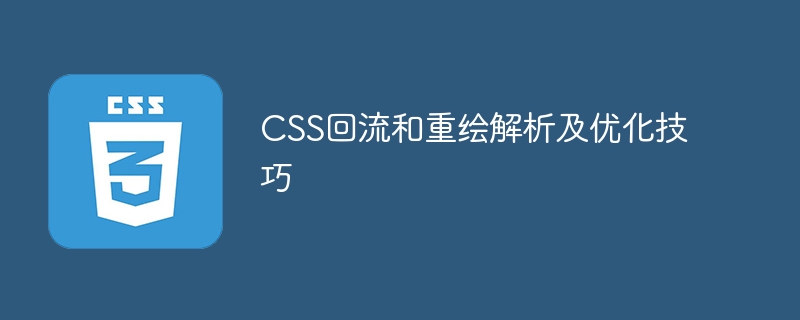

CSS reflow and redraw parsing and optimization techniques
In recent years, web page performance optimization has become an important part of front-end development, including CSS reflow and redraw analysis and optimization. In the process of optimizing CSS, we need to understand the definitions of reflow and redraw, and learn some specific optimization techniques.
Reflow and repaint are the processes by which the browser rendering engine layouts and draws web pages.
Reflow refers to the process of re-rendering the page when the DOM structure changes. For example, when the size, position, text font, etc. of an element change, the browser will recalculate the geometric properties of the element, and then relayout and draw the page.
Redrawing means that when the style of an element changes but does not affect the layout, the browser only needs to redraw the affected part without recalculating the layout.
The overhead of reflow and redraw is very high, so we need to avoid unnecessary reflow and redraw as much as possible to improve page performance and loading speed.
2.1 Use transform to replace top, left and other attributes
When we need to change the position of an element, we can consider using the CSS transform attribute. Using transform will not trigger reflow and redraw because it only visually transforms the element without changing the element's geometric properties and layout. For example:
.box {
transform: translate(100px, 100px);
}2.2 Use the position attribute to control the hierarchical relationship
When you need to change the hierarchical relationship of elements, you can use the CSS position attribute to control the stacking order of elements instead of using z-index Attributes. Changing the z-index will trigger a redraw, but using the position attribute will not.
.box {
position: relative;
}2.3 Merge style modification
When you need to modify the styles of multiple elements, you can merge these modifications together to avoid multiple redraws. For example:
.box1, .box2, .box3 {
width: 100px;
height: 100px;
}2.4 Use offline DOM operations
If you need to modify the DOM multiple times continuously, you can consider using offline DOM operations. That is, the DOM element is removed from the document first, and then reinserted into the document after the modification is completed. This can reduce the number of reflows.
In practice, we can use the browser's development tools to observe the reflow and redrawing of the page in order to optimize the code.
The following is a sample code that demonstrates how to avoid unnecessary reflows and redraws by optimizing CSS:
<style>
.box {
width: 100px;
height: 100px;
background-color: red;
position: relative;
top: 0;
left: 0;
}
</style>
<div class="box"></div>
<script>
let box = document.querySelector('.box');
box.style.transform = 'translate(100px, 100px)';
</script>In this example, by using the transform attribute instead of the top and left attributes, avoid prevents reflow and redrawing from occurring. In this way, the browser only needs to visually transform the elements and does not need to recalculate the layout, thereby improving performance.
Summary
By understanding the concepts of reflow and redraw, and applying optimization techniques, we can minimize unnecessary reflow and redraw, thereby improving page performance and user experience. During the development process, we should pay attention to the way the code is written, and use the browser's development tools to observe the rendering performance of the page and make timely optimization adjustments.
The above is the detailed content of Optimize reflow and redrawing techniques during CSS parsing. For more information, please follow other related articles on the PHP Chinese website!




